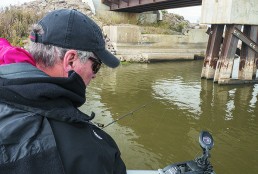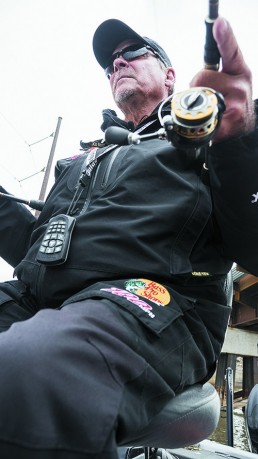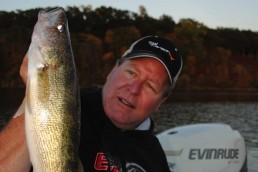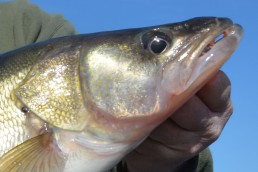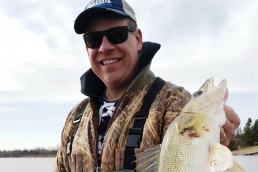Dust the Boat off, Hit the River, Jig up Walleyes
SHARE THIS POST
Spring is in the air, which means it is time to clean out the garage. Since you are going to need space to work, the first thing you need to do is hook the boat up to your truck and pull it onto the driveway.
Once it is out of the garage, take a slow walk around your rig and wipe your finger along the hull of the boat. Now, look at your finger. Is there dust on it? If there is, you have a problem. Obviously, you can’t spend the day cleaning your garage just to park a dusty boat back inside. That’s like tracking mud across a freshly mopped kitchen floor.
As luck would have it, the rivers are open, giving you the perfect place to take your boat for a bath. Being the multi-tasking person that you are, it would only make sense to bring your river fishing gear along to catch a meal at the same time.
One of the best ways to catch walleyes on rivers in the spring is by vertical jigging. Keeping the presentation vertical means you’re fishing with the least amount of line out, therefore you’ve got the most direct line to the fish. The goal is to drift the river the same speed as the current. The biggest problem is usually the wind. No matter if the wind is blowing upstream, downstream, or cross-stream, point the bow into the wind, set the tolling motor speed on a higher setting and use short, powerful bursts to quickly move the boat in order to keep the lines vertical. That way, as soon as the lines angle off to the left, a quick burst of power moving the boat to the left brings them back vertical again. By “following the lines” instead of trying to get the jigs to “follow the boat,” you’ll find it much easier to be successful at vertical jigging. Keep your eyes on the depth finder at all times to maintain proper depth, or hold on a break or channel edge.
When it comes to bait, a basic jig tipped with a minnow has been the go-to presentation for years. Now, even the die-hard river rats are changing their ways. Over the past decade, artificial baits have proven to be just as effective as their live-bait counterparts when it comes to catching walleyes.
They can also save you a lot of time and hassle on the water. Artificials tend to be more durable on the hook than live bait, so you save time not having to re-bait as often. That “stay-on-the-hook” characteristic can occasionally even get you a “second-chance” bite that you would not get if you were using live bait.
For most early-season vertical jigging scenarios, a subtle-action tail will be your best choice. The Berkley Power Jig Worm, a 3-inch worm with a paddle on the back, is one of our favorites. This worm is very limber, which means that you don’t have to put a lot of effort into moving the bait to give it a lot of action. We prefer to stick with natural colors to make the worm look more like a real ‘crawler.
Are you enjoying this post?
You can be among the first to get the latest info on where to go, what to use and how to use it!
Another go-to bait is the Berkley PowerBait Minnow in the 2- or 3-inch size, which mimics a real minnow quite well. We often double-up the baits, threading a 3-inch minnow on the jig right up to the jig head, followed by hooking a 2-inch version through the nose. This tandem bait setup is deadly at times because it increases the lure’s profile, adds a little extra action to the presentation and in the event that a short strike results in the 2-inch minnow being plucked off you can quickly drop the bait back down to the fish, resulting in a second strike to hook it.
We like to work these baits by giving the jig a sharp “pop” off the bottom, followed by holding it for a couple of seconds before slowly lowering it back down. As soon as it hits the bottom, pop it again. The walleyes are relating to the bottom, so keep the pop to a minimum, usually 6 inches. You don’t want to let the jig sit on bottom very long, as it will drag in the current and snag. If you feel weight on the lift, set the hook.
Another bait that can add even more scent appeal to the presentation is the 3-inch Gulp Minnow. The Gulp line is not made of soft plastic. Soft plastics—like the PowerBait line—are made with oil-based resins, whereas Gulp baits are made with a water-base. This allows for much more scent distribution. When scent is added to a bait created from oil-based resins, the oil traps the scent inside the bait. While some of the scent does get out, the oil is actually functioning as a barrier. Gulp, on the other hand, disperses the water-soluble scent as soon as it hits the water; there is no oil barrier keeping the water out. This allows the bait to disperse scent almost like a blood trail, expanding the strike zone by attracting fish that do not see the bait. That’s why it is important to fish Gulp baits slowly, allowing the bait to disperse scent.
Once the water begins to warm up, you will want to move to a bait with more action, such as the 3-inch Berkley PowerBait Ripple Shad. This has a rippled, minnow-shaped body that gives it vibration and swimming action. It also has a paddle tail that puts out a lot of vibration as the lure is retrieved. The Ripple Shad has become a lure that we use almost like we would a mini-crankbait or small swimbait, but with a jigging action rather than a steady retrieve. You want to make sure when you work this lure you jig it in such a way as to make sure that the paddle tail vibrates vigorously on the upswing and flutters as it drops back down. Fish the Ripple Shad on a heavier jig than you would normally fish live bait, typically in the 1/4- to 3/8- ounce range. This will help you get the action needed to make the tail work the way you want.
Another great bait in warmer water is the 4-inch Berkley PowerBait Pro Shad. Like the Ripple Shad, it has a paddle tail that helps to attract the walleyes through vibration. The large minnow profile gives it a very realistic look.
As the water continues to warm up throughout the spring, don’t be afraid to push the envelope with your presentation. A Moonshine Shiver Minnow is a great bait to use for more aggressive walleyes. The darting action of the lure catches the attention of the fish. Drop it down to just above bottom and then “pop” it up to make it jump. Then give the lure some slack to make it turn around and return to the starting position. Hold the lure in place and “shiver” it with a quick shake of the rod tip. This will make it look like a minnow holding in current. You can use these baits tipped or untipped.
By now, you should have enough fish for a meal, as well as the winter dust washed off your boat. But cleaning the garage can wait another day.
MWO
SHARE THIS POST
Did you enjoy this post?
You can be among the first to get the latest info on where to go, what to use and how to use it!
Parsons/Kavajecz
Gary Parsons and Keith Kavajecz are professional walleye anglers specializing in tournament fishing and walleye fishing promotions. Both are “Legendary Angler” inductees into the National Fresh Water Fishing Hall of Fame, accomplished authors and co-hosts of the popular The Next Bite TV show. For more info: thenextbite.tv.
